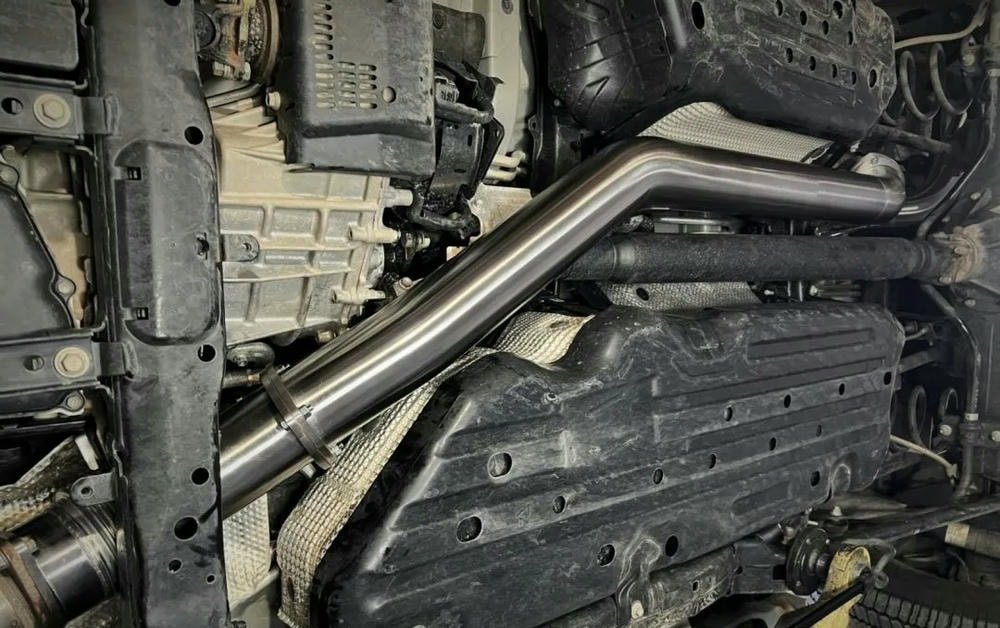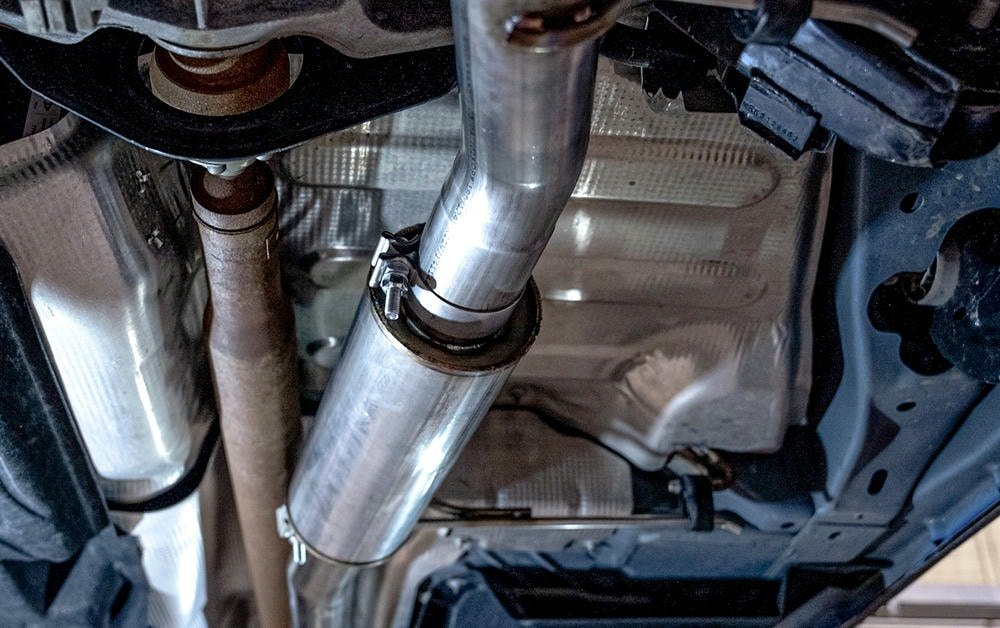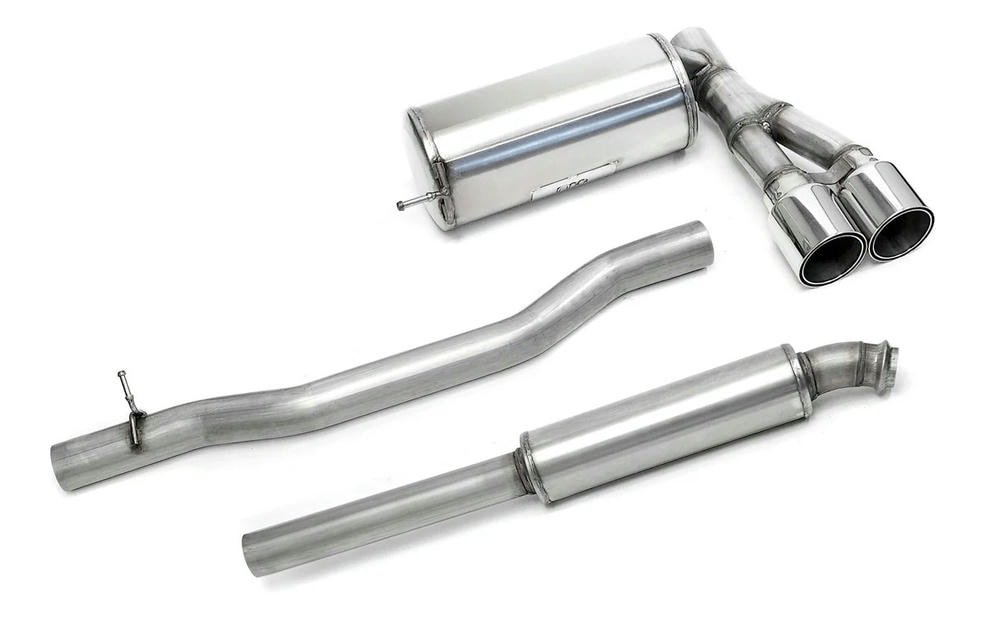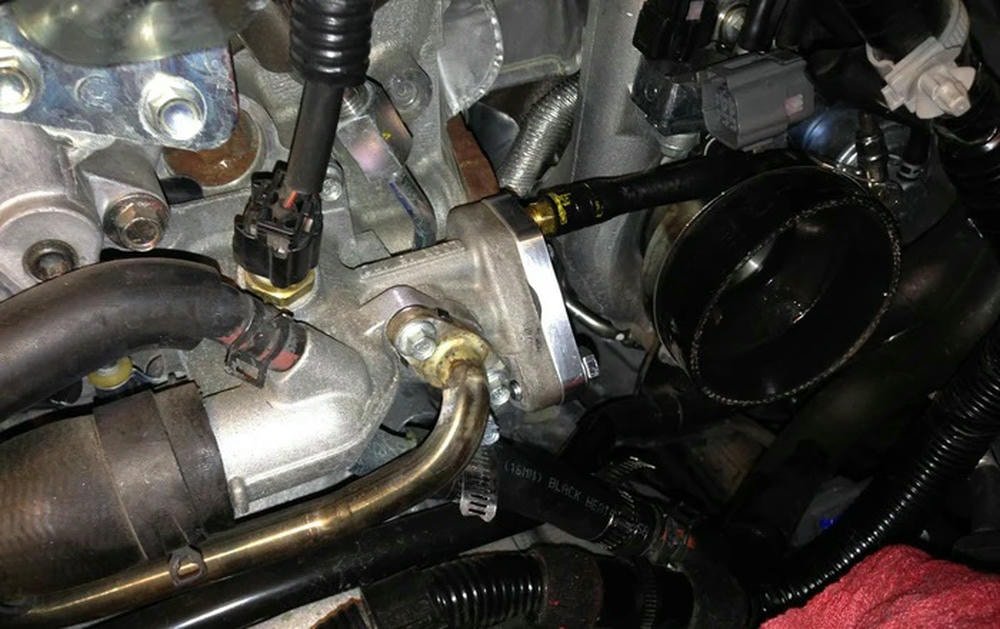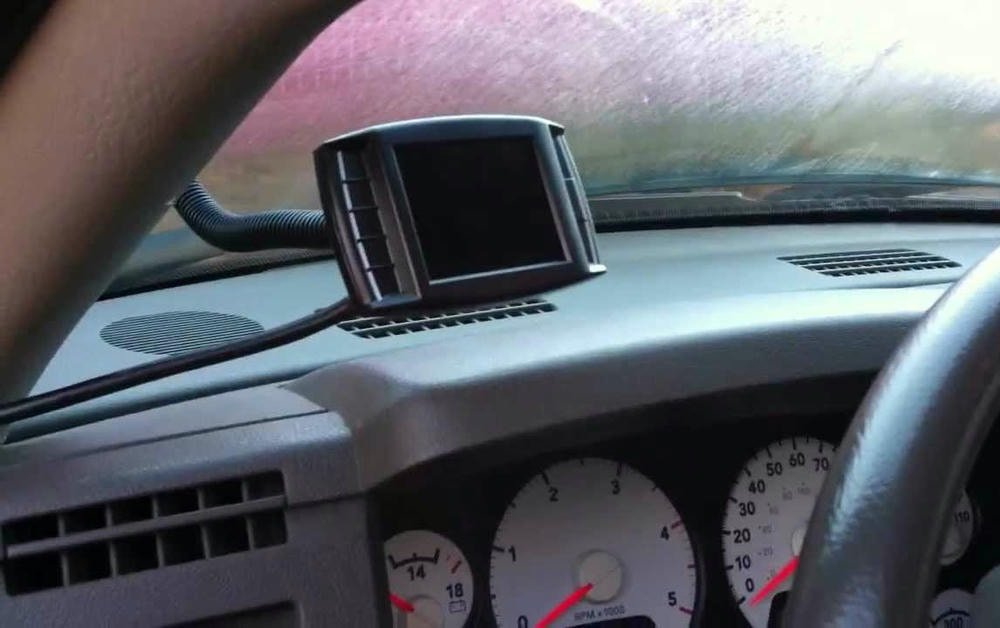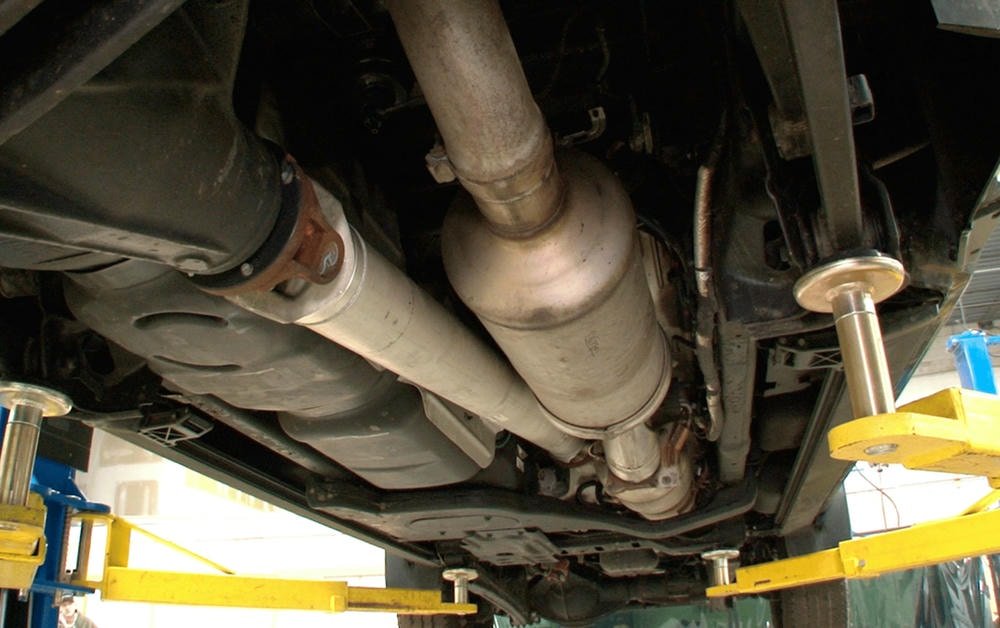Indice dei contenuti
ToggleImportance of understanding potential issues with DPF back exhaust systems.
Knowing the issues with DPF back exhaust systems helps diesel truck owners keep their trucks running well. The Diesel Particulate Filter (DPF) catches soot and smoke from exhaust gases to lower air pollution.
But, if there’s a problem with the system behind this filter, it can lead to bad performance or damage. Troubleshooting these issues early saves money and keeps emissions low.
Common problems like leaks in the exhaust, reduced engine power, strange noises, or the check engine light turning on need quick action. Recognizing signs of trouble allows for timely repairs.
This protects not just the vehicle but also meets strict emissions standards aimed at keeping the air clean.
Common Issues with DPF Back Exhaust Systems
Owners of diesel trucks often see problems with their DPF back exhaust systems. These issues can affect the truck’s power and how well it runs.
Exhaust Leaks
Exhaust leaks in DPF back exhaust systems can cause less power and more fuel use. These leaks let gases escape before they pass through the diesel particulate filter (DPF). This means the truck does not clean the soot and particles as well.
Mechanics look for holes or cracks in pipes, joints that are not tight, and damaged gaskets to find these leaks.
Fixing leaks early helps keep the system working right. They might change broken parts or make connections fit better. Using the right engine oils and conducting regular checks also prevents future leaks.
Diesel truck drivers need to take care of their trucks to avoid such problems with exhaust emissions and performance drops.
Reduced Performance
Diesel truck owners often observe a decline in performance with DPF back exhaust systems. This implies the truck does not go as swiftly or use fuel as effectively. One potential cause could be soot accumulation in the diesel particulate filter (DPF).
Soot can impede air flow in the exhaust, causing the engine to exert more effort. This results in less power and increased fuel consumption.
From direct experience, monitoring soot levels can be beneficial. A routine inspection detects issues at an early stage. For example, employing performance enhancing tools can identify if there’s a decrease in speed or power.
Regularly cleaning the DPF can also prevent these complications.
Regular maintenance keeps your diesel running smooth and efficient.
Unusual Noises or Vibrations
Owners of diesel trucks often hear odd sounds or feel shakes from their DPF back exhaust systems. These signs can mean trouble. Loose parts, holes, or breaks in the exhaust path cause these problems.
For instance, a failing muffler might start to rattle due to internal damage. Or, a loose connection at the tailpipe could lead to vibrations that are easy to feel.
Fixing these issues starts with finding out where the noise or shake is coming from. One should check each part of the exhaust line closely. This means looking at clamps, hangers, and gaskets for signs of wear or looseness.
A mechanic uses tools like stethoscopes made for car work to pinpoint where a rattling sound is coming from within complex parts like catalytic converters or particulate filters.
Attivazione della spia del motore di controllo
Il check engine light turning on in diesel trucks often signals issues with the DPF back exhaust system. This warning sign can point to a variety of problems, from blocked filters full of soot particles and particulate matter to issues with the emission standard systems such as EGR (exhaust gas recirculation) or PCV (positive crankcase ventilation).
Diesel vehicle owners should take this alert seriously as it indicates that the truck’s ability to manage exhaust fumes and maintain air quality is compromised.
Acting on a check engine light promptly helps prevent damage and maintains performance gains with DPF back exhaust systems. A diagnosis might involve checking for error codes related to the turbocharger, which affects mileage and reliability, or inspecting components like the exhaust manifold for leaks or wear.
Clearing these codes after fixing any identified issues is crucial for resetting the system. Keeping an eye on this light ensures diesel engines run efficiently while meeting automobile emissions standards vital for reducing smog and protecting clean air.
Diagnosing Problems in DPF Back Exhaust Systems
Finding out what’s wrong with DPF back exhaust systems needs a good eye. You need to look closely for any signs of trouble. This includes checking for holes or damage and listening for odd sounds.
Tools like pressure sensors and temperature gauges help check how well the system works. Learn more about spotting and fixing these issues to keep diesel trucks running smoothly.
Visual Inspection for Leaks and Damage
Troubleshooting DPF back exhaust issues starts with a thorough visual inspection. This step is crucial for diesel truck owners who want to keep their vehicles in top shape.
- Check the tail pipe for signs of soot. This can indicate a leak or problem in the DPF system.
- Look at the exhaust components for any visible cracks or holes, especially near welds and joins.
- Ispezionare hangers and mounts for damage or wear that could lead to misalignment or parts rubbing together.
- Use a flashlight to search for small leaks or damage not easily seen with the naked eye.
- Feel around joints and connections for any air escaping, which might not be visible but could suggest a leak.
- Observe the color of exhaust gases. Black smoke can point toward incomplete combustion, while blue smoke suggests oil burning, both hinting at potential issues.
- Detect any unusual smells from the exhaust, as these can indicate leaks allowing fumes to escape.
- Listen for hissing or tapping sounds near the exhaust manifold, turbocharger, and DPF filter when the engine is running but stationary.
- Monitor exhaust gas temperature sensors’ readings if available, as spikes could show blockages or malfunctions in the DPF filter.
- Examine sealing gaskets between sistema di scarico components for deterioration that could allow leaks.
Each of these steps helps highlight different areas where leaks or damage might occur within a diesel vehicle’s DPF back exhaust system, guiding owners toward necessary repairs or adjustments to ensure optimal performance and longevity of their trucks’ systems.
Testing for Performance Loss
Diesel truck owners often face performance issues with their DPF back exhaust systems. Identifying and fixing these problems early can save time and money.
- Utilizzare un performance monitor to track engine efficiency. This device helps detect any drop in power output or fuel economy, which are signs of DPF back exhaust system troubles.
- Inspect the turbocharger for signs of damage or wear. A faulty turbocharger can lead to reduced engine power, affecting overall vehicle performance.
- Check for perdite di gas di scarico by listening for unusual sounds or using a smoke machine. Leaks can reduce the effectiveness of the DPF system, leading to performance issues.
- Monitor diesel particulate levels with an EGR (Exhaust Gas Recirculation) system diagnostic tool. High levels indicate the DPF is not filtering properly.
- Review error codes from the vehicle’s computer with an OBD-II scanner. Codes related to the DPF or exhaust system can pinpoint specific problems causing performance loss.
- Test airflow through the sistema di scarico using a flow meter. Restricted airflow can be caused by blockages or damaged components in the DPF back exhaust system.
- Esaminare iniettori di carburante for proper operation as they significantly impact engine performance and efficiency.
- Perform a dyno test to measure actual horsepower and torque versus factory specs if all other diagnostics do not reveal clear issues.
From personal experience, staying on top of these checks has prevented major repairs and maintained optimal diesel vehicle performance over time.
Identifying Source of Noises
Detecting the origins of noises from a DPF back exhaust system can aid diesel truck proprietors in resolving issues promptly. This guide assists in highlighting the usual sources of these auditory disturbances.
- Monitor for hissing or whistling sounds beneath the truck. These often imply an exhaust leak, possibly near the turbocharger or connections.
- Heed rattling noises when initiating the engine or driving at low velocities. Unsecured components in the sistema di scarico, like clamps or mounts, might result in this.
- Acknowledge any profound rumbling noises during acceleration. A compromised DPF filter might be at fault.
- Verify if the noise amplifies with velocity. This might suggest complications with the muffler or pipes being depleted.
- Be cautious of popping noises during initiation or termination. They could denote back-pressure issues due to obstructions in the DPF system.
- Monitor for regular ticking near the engine area during idle. This could signify a leaky header collector gasket.
- Determining vibrations that accompany noises assists in pinpointing unsecured elements or damaged sections.
By identifying these indicators, diesel vehicle proprietors can act instantly to troubleshoot DPF back exhaust performance complications and manage their trucks effectively.
How to Fix Common Problems
Fixing issues with DPF back exhaust systems often involves hands-on work. For leaks or damage, one might need to replace parts or seal gaps securely. Adjusting the way parts fit together can also solve some problems.
Sometimes, a mechanic needs to reset the vehicle’s computer and clear error messages to get everything running smoothly again.
Repairing or Replacing Damaged Components
Repairing or replacing damaged parts is key to keeping a diesel truck’s DPF back exhaust system working well. Diesel particulate filters (DPFs) and other parts may break down over time, affecting performance. Here’s how diesel truck owners can address these issues:
- Identify the Issue: Use diagnostic tools to find out what part of the DPF back exhaust is not working right. This might show if there are leaks or blockages.
- Inspect for Damage: Look carefully at the DPF, turbocharger, and exhaust pipes for any segni di usura o danni like holes or cracks.
- Check Connections: Make sure all connections between different parts of the sistema di scarico are tight and fit well. Loose connections can lead to leaks.
- Replace Filters Regularly: The DPF catches soot and other particles from exhaust gases. Change it as needed to keep exhaust flow smooth.
- Use High-Quality Parts: When replacing a part, choose high-quality ones that match your truck’s specifications. This helps avoid future problems.
- Reset the ECU (Engine Control Unit): After fixing or changing parts, reset the ECU to clear old error codes and help your truck adjust to the new components.
- Follow Manufacturer Guidelines: Always stick to the repair instructions from your truck’s maker when fixing or changing parts.
- Professional Help: If you’re unsure about doing repairs yourself, get help from a professional mechanic who knows about diesel trucks and DPF systems.
Taking care of these steps ensures that your diesel truck’s DPF back exhaust system stays in good shape, offering better performance and fuel efficiency.
Adjusting Fitment and Connections
Adjusting fitment and connections is crucial for diesel truck owners aiming to keep their DPF back exhaust systems in top shape. Proper adjustments ensure exhaust gases flow efficiently, reducing performance issues.
- Controllo clamps and bolts for tightness: These components should be secure but not overly tight, as this could damage the exhaust parts.
- Ispezionare rubber mounts for wear: Worn-out mounts can cause the sistema di scarico to hang lower than intended, leading to potential damage.
- Utilizzare un Chiave dinamometrica: To avoid over-tightening, apply the manufacturer-recommended amount of torque to all bolts and clamps.
- Align the exhaust tips properly: They should be even and straight at the back of your truck to ensure a good look and proper discharge of gases.
- Ensure there is enough clearance: The sistema di scarico should not touch any part of the truck’s body or frame to prevent heat damage and vibrations.
- Listen for unusual sounds: After adjusting, start your truck and listen for any rattles or leaks that indicate loose connections.
- Do a test drive: This helps identify any issues with fitment or connections that might only appear under driving conditions.
Making these adjustments helps maintain optimal performance of DPF back exhaust systems in diesel trucks, ensuring efficient operation and longevity of the components.
Resetting ECU and Clearing Codes
Resetting the ECU (Engine Control Unit) and clearing codes is a critical step for diesel truck owners. This process helps keep their vehicles running smoothly.
- Locate the OBD-II (On-Board Diagnostics II) port under the dashboard on the driver’s side.
- Plug in an OBD-II scanner to the port.
- Turn on the ignition to power up the engine control unit and scanner without starting the engine.
- Wait for the scanner to connect with your vehicle’s ECU.
- Select ‘Read Codes‘ to see any stored error codes that might indicate problems.
- Choose ‘Clear Codes‘ or ‘Reset’ on your scanner, which deletes any error messages from the ECU.
- Unplug the scanner and turn off the ignition.
- Start your engine to ensure it runs normally, observing changes in performance or unusual sounds that may need further attention.
This reset can improve diesel exhaust problems, enhancing DPF back exhaust performance and maintenance.
Prevenire i problemi futuri
To stop problems before they start, keeping up with routine care and checks on your diesel truck’s exhaust system is key. This includes getting it looked at often and making sure everything is put in right from the start.
Manutenzione e ispezioni regolari
Regular maintenance and inspections are key to keeping diesel trucks running smoothly. They prevent many common problems with DPF back exhaust systems.
- Check the exhaust system for leaks often. Small holes can turn into big problems quickly.
- Inspect all connections and clamps. Make sure they are tight and not corroded.
- Clean the DPF filter regularly. This stops soot build-up which can slow down your truck.
- Examine the EGR valve often for signs of wear or damage. It helps control emissions but can get clogged.
- Replace old or worn-out parts like guarnizioni e sigilli to stop leaks before they start.
- Utilizzo quality lubricants that are right for diesel vehicles. Good oil keeps everything running smoother.
- Schedule professional checks of the turbocompressore yearly. It boosts engine power but needs care.
- Watch out for changes in performance or sound from the exhaust, which could mean trouble.
- Keep track of mileage between maintenance sessions to stay on schedule.
Doing these steps helps keep diesel trucks in good shape and avoids bigger issues later on with their DPF back exhausts systems, ensuring both better performance and lower repair costs over time.
Garantire una corretta installazione
The correct assembly of a DPF back exhaust system is vital to prevent performance hindrances in diesel trucks. An error in this process can lead to perdite di gas di scarico, diminished engine efficiency, e undesired noises.
It’s critical that all components fit adequately and connections are securely fastened. For those undertaking this task at home, adhering to the manufacturer’s instructions closely is crucial.
This validates alignment and tightening of all parts are done properly.
Through personal encounter, a lot of truck owners discern that vigilant observation during the assembly saves time later in resolving issues. Utilizing appropriate tools like torque wrenches facilitates this exactitude.
Additionally, understanding your truck model’s distinctive necessities can avert familiar drawbacks. For example, a GMC Sierra might necessitate different fitment requirements compared to a Silverado or Denali.
A properly assembled DPF back exhaust amplifies performance and also prolongs the durability of your diesel truck.
Upgrading
Upgrading your diesel truck’s DPF back exhaust system can boost its performance. It makes the truck run smoother and sound better. This is important for those who care about how their vehicle performs on the road.
Upgrades can include new pipes, mufflers, or even a complete system overhaul to improve flow rate and reduce exhaust gas recirculation (EGR). These changes help in pushing out soot and particulate material more effectively.
Scegliere il giusto upgrades means looking at quality parts meant for diesels. Better materials mean less chance of leaks or damage later. Companies make special components that fit well with your truck’s model and year.
Installing these upgraded parts might require professional help to ensure everything fits just right and works as it should. This keeps the diesel running efficiently while helping prevent future exhaust issues.
Conclusione
This guide helps diesel truck owners fix and prevent problems with their DPF back exhaust systems. Mark Johnson, an expert in vehicle exhaust systems, offers his insights. With years of experience, a degree in mechanical engineering, and many articles published on this topic, Mark is well-known.
Mark says the tips shared here are key to keeping trucks running well. He talks about how proper maintenance stops common issues like leaks and noise from happening. These steps follow scientific principles that keep engines safe and efficient.
He stresses safety and honesty in exhaust system care. Following rules and being open about any changes made to a truck is important for everyone’s safety on the road.
Mark recommends regular checks and correct installation to avoid big problems later. His advice aims at making these tasks easy for truck owners.
Comparing this guide to others, Mark finds it practical but reminds readers that no solution fits every problem perfectly. He advises looking at the truck’s specific needs before deciding.
Overall, Mark believes this troubleshooting guide is very useful for diesel truck owners. It gives solid advice on keeping their vehicles in top shape.
Domande frequenti
What is a DPF back exhaust system and how does it work?
A DPF back exhaust system is a performance-enhancing component in diesel vehicles that helps reduce the emission of diesel particulates. It involves heating up the particles in the combustion chamber to over 600 degrees Fahrenheit for efficient burning.
How can I maintain my DPF back exhaust system for optimal performance?
Maintenance tips for your DPF back exhaust include regular checks for signs of blow-by, which could indicate pre-ignition issues, and ensuring proper care of all components including turbocharger maintenance.
What common problems might I encounter with my DPF back exhaust system?
Common issues with these systems may include leaks requiring repair, inadequate mileage affecting overall performance, or more complex challenges related to specific parts like Eolys fluid or Euro 5 compliant systems.
How can I troubleshoot my DPF back exhaust system if I suspect there’s an issue?
To fix potential problems with your custom exhaust maintenance routine, you’ll need to follow a systematic troubleshooting process that includes checking each part of the system from cat-back to denail components while keeping an eye out for telltale signs like excessive smoke or unusual noises.
Are there any historical context or environmental factors that could affect my DPF Back Exhaust System’s functioning?
Yes! For instance, driving conditions such as extreme heat from bushfires along routes like Australia’s Great Central Road could cause additional strain on your vehicle’s engine and its associated systems like Corvette Stingray’s specialized setup.

